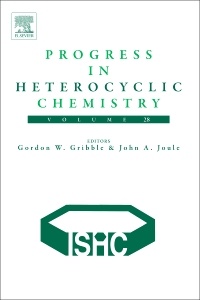Description
Progress in Heterocyclic Chemistry
Progress in Heterocyclic Chemistry Series
Authors: Gribble Gordon, Joule John A.
Language: English
Subject for Progress in Heterocyclic Chemistry:
Keywords
�-Lactams; (Thio)Pyrans; 1; 2; 3-Triazoles; 1; 2; 4-Triazoles; 1; 2; 4-Trioxolanes; 1; 2-Dioxolanes; 1; 2-Dithioles; 1; 2-Oxathioles; 1; 3; 2-Dioxathiolanes; 1; 3-Dioxol-2-ones; 1; 3-Dioxoles; 1; 3-Dipole; 1; 3-Dithioles; 1; 3-Oxathioles; 2-Azetidinones (�-Lactams)2-Oxetanones (�-Lactones)�-Thiolactones; Annulation; Applications; Aromaticity; Azaheterocycles; Azaindole; Azanaphtalenes; Azepane; Azetidines; Azetines; Aziridination; Aziridines; Azirines; Benzazepine; Benzo[b]furan; Benzo[c]furan; Benzodiazepine; Benzopyran derivatives; Benzothiazole; Bicyclic azetidin-2-ones; Bioactive compounds; Calixarenes; Carbazole; Catalyst; Chromones; Cinnolines; Click chemistry; Corroles; Coumarins; Coupling; Cross-conjugated; Crown ethers; Cycloadditions; Di; tri; and tetraoxanes; Diazepine; Dihydrobenzo[b]furan; Dioxepine; Dioxetanes; Dioxolanones; Dithiepine; Dithiolanes; Enzymatic reactions; Epoxidation; Epoxides; Four-membered silylenes; Frontier orbitals; Furans; Fused nitrogen heterocycles; Fused rings; Heptazines; Imidazoles; Indole; Indoxyl; Isatin; Isoindole; Isoquinoline; Isothiazole; Isoxazoles; Isoxazolidines; Isoxazolines; Macroheterocycles; Medicinal and materials; Mesoionic; Mesomeric betaine; Metal-catalyzed reactions; Molecular hybridization; Non-Kekul�Semi-conjugated; Oxadiazoles; Oxathianes; Oxathiepine; Oxathiolanes; Oxazepane; Oxazoles; Oxazolidines; Oxazolines; Oxepane; Oxetanes; Oxindole; Oxiranes; Phenazines; Phosphetanes; Phthalazines; Piperidines; Polyazarings; Porphyrins; Preparations; Pteridines; Purines; Pyranones; Pyrazines; Pyrazoles; Pyridazines; Pyridine N-oxide; Pyridine; Pyrimidines; Pyrrole; Quinazolines; Quinoline; Quinoxalines; Ring transformations; Selenophenes; Spirooxindole; Stereoselectivity; Supramacromolecules; Synthesis; Tellurophene and their derivatives; Tetrahydrofurans; Tetrazines; Tetrazoles; Thiacalix[n]arenes; Thiadiazole; Thiazepine; Thiazole; Thiazoline; Thiepine; Thietanes; Thiophenes; Triazines; Xanthenes; Xanthones
682 p. · 15x22.8 cm · Hardback
Out of Print
Description
/li>Contents
/li>Biography
/li>Comment
/li>
Progress in Heterocyclic Chemistry (PHC), Volume 28 is an annual review series commissioned by theInternational Society of Heterocyclic Chemistry (ISHC). Volumes in the series contain both highlights of the previous year?s literature on heterocyclic chemistry and articles on new and developing topics of particular interest to heterocyclic chemists.
The highlight chapters in Volume 28 are all written by leading researchers and constitute a systematic survey of the important original material reported in the literature of heterocyclic chemistry during 2015. Additional articles in this volume include Semi-conjugated Heteroaromatic Rings and beta-Lactam Chemistry.
As with previous volumes in the series, Volume 28 will enable academic and industrial chemists, and advanced students, to keep abreast of developments in heterocyclic chemistry in a convenient way.
1. Semi-conjugated Heteroaromatic Rings: A Missing Link in Heterocyclic Chemistry 2. Recent Progress in the Use of Functionalized B- Lactams as Building Blocks in Heterocyclic Chemistry 3. Three-Membered Ring Systems 4. Four-Membered Ring Systems 5.1. Five-Membered Ring Systems: Thiophenes and Se/Te Derivatives 5.2. Five-Membered Ring Systems: Pyrroles And Benzo Analogs 5.3. Five-Membered Ring Systems: Furans and Benzofurans 5.4. Five Membered Ring Systems: With More than One N Atom 5.5. Five-Membered Ring Systems: With N and S (Se) Atom 5.6. Five-Membered Ring Systems: With O & S (Se, Te) Atoms 5.7. Five-Membered Ring Systems with O & N Atoms 6.1. Six-Membered Ring Systems: Pyridines And Benzo Derivatives 6.2. Six-Membered Ring Systems: Diazines and Benzo Derivatives 6.3. Triazines, tetrazines and fused ring polyaza systems 6.4. Six-Membered Ring Systems: With O and/or S Atoms 7. Seven-Membered Rings 8. Eight-Membered and Larger Rings
Gordon Gribble is the Dartmouth Professor of Chemistry at Dartmouth College, Hanover, USA. His research program covers several areas of organic chemistry, most of which involve synthesis, including novel indole chemistry, triterpenoid synthesis, DNA intercalation, and new synthetic methodology. Prof. Gribble also has a deep interest in naturally occurring organohalogen compounds and in the chemistry of wine and wine making.
John Arthur Joule did his BSc, MSc, and PhD degrees at The University of Manchester, obtaining his PhD in 1961. He then undertook post-doctoral work at Princeton University and Stanford University, before joining the academic staff of the Chemistry Department at The University of Manchester in 1963, where he is currently a Professor. In 1996 he received an RSC Medal for Heterocyclic Chemistry.
- Recognized as the premiere review of heterocyclic chemistry
- Includes contributions from leading researchers in the field
- Provides a systematic survey of the important 2015 heterocyclic chemistry literature
- Presents articles on new and developing topics of interest to heterocyclic chemists
These books may interest you

Progress in Heterocyclic Chemistry 147.64 €

Progress in Heterocyclic Chemistry 220.63 €

Progress in Heterocyclic Chemistry 242.37 €

